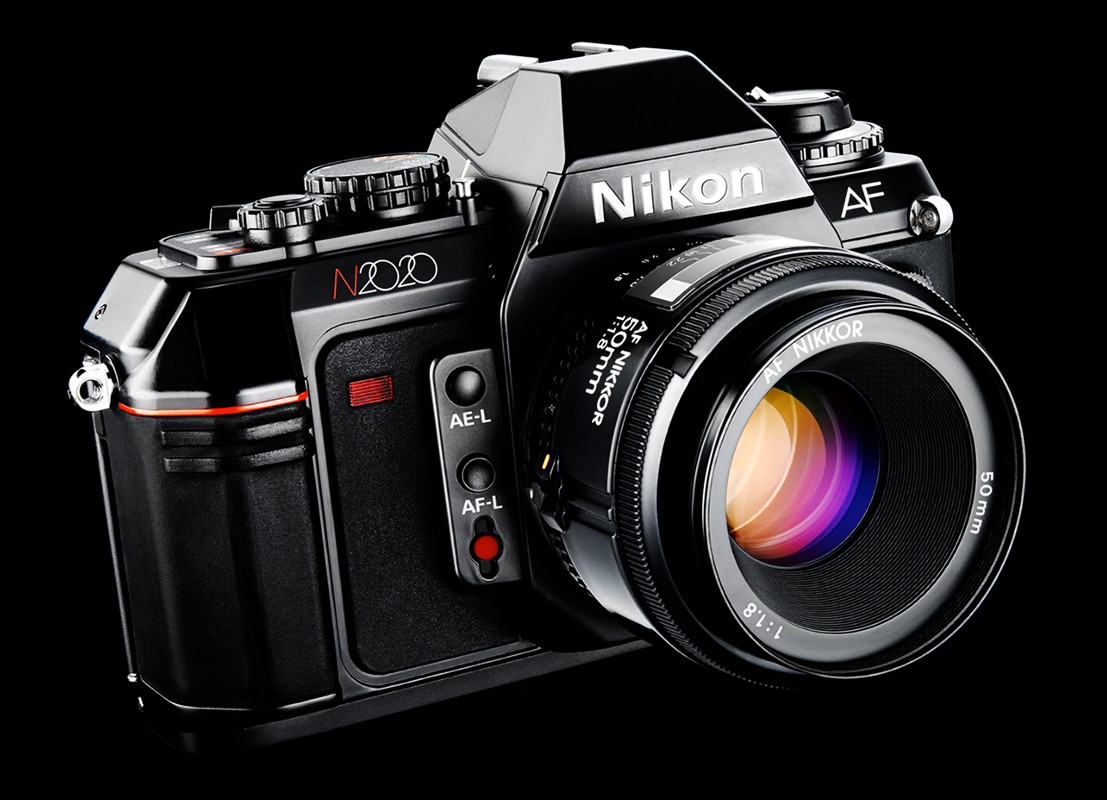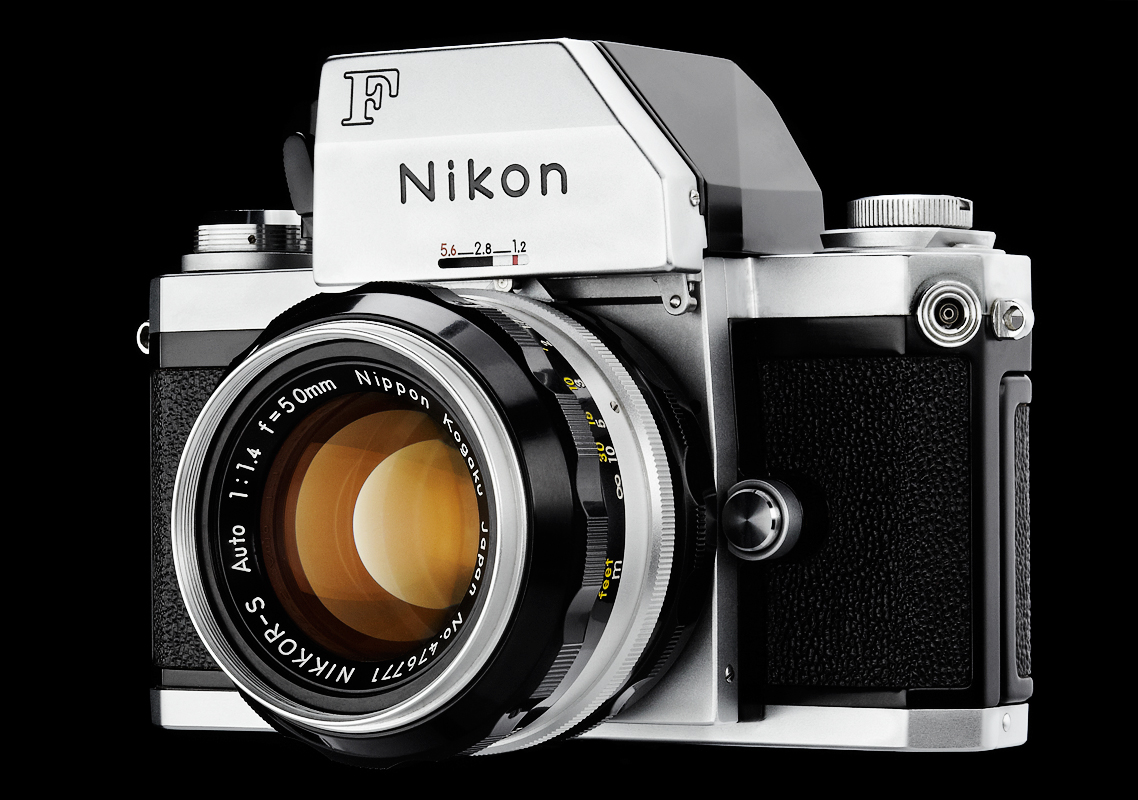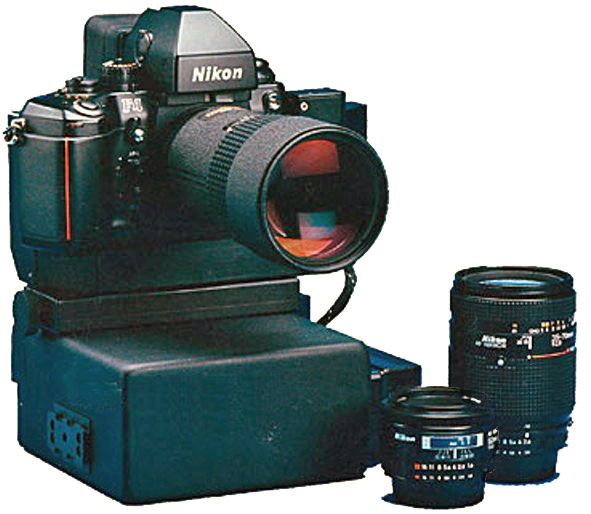|
F-501
The Nikon F-501 (sold in North America as the N2020) was the first successful autofocus SLR camera sold by the Nikon Corporation beginning in 1986. A nearly identical, albeit manual focus version, called the Nikon F-301 (N2000 in North America) was also available. Subsequent models in the consumer line included the Nikon F-401, Nikon F-601, and Nikon F-801 / Nikon F-801s, F-801s. Features The F-501 is a 35mm format, 35 mm single-lens reflex camera with automatic film loading and advance, almost a first for Nikon (the Nikon F301, F-301 was their first SLR to feature this). The built-in motor drive provides single (one exposure and frame advance per shutter button press) or continuous (shutter will fire and film will advance so long as the shutter button is depressed) modes. Maximum film advance speed is 2.5 frames per second (frame/s) on continuous mode, but can be as slow as 1.4 frames/s depending on the status of the focus/exposure locks. Rewind is accomplished manually by a fa ... [...More Info...] [...Related Items...] OR: [Wikipedia] [Google] [Baidu] |
Nikon F-mount
The Nikon F-mount is a type of interchangeable lens mount developed by Nikon for its 35mm format single-lens reflex cameras. The F-mount was first introduced on the Nikon F camera in 1959, and features a three-lug bayonet mount with a 44mm throat and a Flange focal distance, flange to focal plane distance of 46.5mm. The company continues, with the 2020 D6 model, to use variations of the same lens mount specification for its film and digital single-lens reflex camera, digital SLR cameras. History The Nikon F-mount is one of only two SLR lens mounts (the other being the Pentax K-mount) which were not abandoned by their associated manufacturer upon the introduction of autofocus, but rather extended to meet new requirements related to light meter, metering, autofocus, and aperture control. The large variety of F-mount compatible lenses makes it the largest system of interchangeable flange-mount photographic lenses in history. Over 400 different Nikkor lenses are compatible with th ... [...More Info...] [...Related Items...] OR: [Wikipedia] [Google] [Baidu] |
Nikon F-801s
The Nikon F-801 (sold as the N8008 in the US market) is a 35mm SLR released worldwide in June 1988 and manufactured until 1991, when it was replaced by the improved Nikon F-801s (N8008s in the US), which in turn was discontinued in early 1995. Although its autofocus mechanism is slow in comparison to modern standards, it was an improvement on Nikon's first attempt at an autofocus SLR - the F-501 (N2020 in North America), and proved to be reliable and durable, typical of Nikon's cameras. Features Despite being designated in the number range usually reserved for amateur cameras (indicated by the non-single digit after the F, eg. not F3), the F-801 was built to a high standard and incorporated a number of professional features: * A Depth of Field preview button allows temporary stopping down to the shooting aperture to check DOF. * A Multiple Exposure facility allows up to nine shots within one frame. * A unique 'two shot' self-timer. This allowed a second shot to be taken by the ... [...More Info...] [...Related Items...] OR: [Wikipedia] [Google] [Baidu] |
Nikon F-801
The Nikon F-801 (sold as the N8008 in the US market) is a 35mm SLR released worldwide in June 1988 and manufactured until 1991, when it was replaced by the improved Nikon F-801s (N8008s in the US), which in turn was discontinued in early 1995. Although its autofocus mechanism is slow in comparison to modern standards, it was an improvement on Nikon's first attempt at an autofocus SLR - the F-501 (N2020 in North America), and proved to be reliable and durable, typical of Nikon's cameras. Features Despite being designated in the number range usually reserved for amateur cameras (indicated by the non-single digit after the F, eg. not F3), the F-801 was built to a high standard and incorporated a number of professional features: * A Depth of Field preview button allows temporary stopping down to the shooting aperture to check DOF. * A Multiple Exposure facility allows up to nine shots within one frame. * A unique 'two shot' self-timer. This allowed a second shot to be taken by the ... [...More Info...] [...Related Items...] OR: [Wikipedia] [Google] [Baidu] |
Nikon AF-SLR Cameras
(, ; ), also known just as Nikon, is a Japanese multinational corporation headquartered in Tokyo, Japan, specializing in optics and imaging products. The companies held by Nikon form the Nikon Group. Nikon's products include cameras, camera lenses, binoculars, microscopes, ophthalmic lenses, measurement instruments, rifle scopes, spotting scopes, and the steppers used in the photolithography steps of semiconductor fabrication, of which it is the world's second largest manufacturer. The company is the eighth-largest chip equipment maker as reported in 2017. Also, it has diversified into new areas like 3D printing and regenerative medicine to compensate for the shrinking digital camera market. Among Nikon's many notable product lines are Nikkor imaging lenses (for F-mount cameras, large format photography, photographic enlargers, and other applications), the Nikon F-series of 35 mm film SLR cameras, the Nikon D-series of digital SLR cameras, the Nikon Z-series of digital mirro ... [...More Info...] [...Related Items...] OR: [Wikipedia] [Google] [Baidu] |
Nikon Corporation
(, ; ), also known just as Nikon, is a Japanese multinational corporation headquartered in Tokyo, Japan, specializing in optics and imaging products. The companies held by Nikon form the Nikon Group. Nikon's products include cameras, camera lenses, binoculars, microscopes, ophthalmic lenses, measurement instruments, rifle scopes, spotting scopes, and the steppers used in the photolithography steps of semiconductor fabrication, of which it is the world's second largest manufacturer. The company is the eighth-largest chip equipment maker as reported in 2017. Also, it has diversified into new areas like 3D printing and regenerative medicine to compensate for the shrinking digital camera market. Among Nikon's many notable product lines are Nikkor imaging lenses (for F-mount cameras, large format photography, photographic enlargers, and other applications), the Nikon F-series of 35 mm film SLR cameras, the Nikon D-series of digital SLR cameras, the Nikon Z-series of digital ... [...More Info...] [...Related Items...] OR: [Wikipedia] [Google] [Baidu] |
Nikon F301
The Nikon F-301 (sold in the United States as the N2000) is a manual focus, autoexposure, auto film loading and advancing 35mm format, 35 mm single-lens reflex camera, SLR camera that was sold by the Nikon Corporation beginning in 1985. It was the replacement for the Nikon FG, FG. The F-301 was identical to the Nikon F501, Nikon F-501 (sold in North America as the N2020) in almost every way, except it lacked autofocus. The Nikon F-301 is notable for being the first Nikon SLR sold that lacked a film advance lever. As a result the selector knob, also used to lock the shutter button, has a continuous option in addition to the single shot. It was also the first Nikon SLR to feature DX film decoding. A standard hotshoe flash mount sits above the viewfinder, with which a flash may be attached to the camera. The Nikon F-301 does not feature a built-in pop-up flash (the Nikon F401, F-401 was the first Nikon SLR to have this feature). It was also the first Nikon to use polycarbonates in ... [...More Info...] [...Related Items...] OR: [Wikipedia] [Google] [Baidu] |
Nikon F-401
The Nikon F-401 (N4004 in North America) was a beginner's level, autofocus, 35mm, single-lens reflex (SLR) film camera built by Nikon and introduced in 1987. The camera represented one of Nikon's first endeavours into consumer-based autofocus, as a follow-up to their first autofocus SLR in 1986, the Nikon F-501 (known as the N2020 in North America). The camera lacked many of the advanced features that more seasoned amateurs and professionals required, but it was a harbinger of the future as it included a pronounced, built-in grip as well as an integrated TTL Flash that is now commonplace on all but the most high-end SLR cameras. The F-401 introduced the now common-place feature of using a thumbwheel instead of lens aperture ring to adjust the aperture. Furthermore, the camera's lack of support for AI lenses meant that while all previous Nikon lenses could be mounted to the camera, none supported automatic exposure TTL metering. By the 1990s, the F-401 was part of a lineup of au ... [...More Info...] [...Related Items...] OR: [Wikipedia] [Google] [Baidu] |
Nikon F-301
The Nikon F-301 (sold in the United States as the N2000) is a manual focus, autoexposure, auto film loading and advancing 35 mm SLR camera that was sold by the Nikon Corporation beginning in 1985. It was the replacement for the FG. The F-301 was identical to the Nikon F-501 (sold in North America as the N2020) in almost every way, except it lacked autofocus. The Nikon F-301 is notable for being the first Nikon SLR sold that lacked a film advance lever. As a result the selector knob, also used to lock the shutter button, has a continuous option in addition to the single shot. It was also the first Nikon SLR to feature DX film decoding. A standard hotshoe flash mount sits above the viewfinder, with which a flash may be attached to the camera. The Nikon F-301 does not feature a built-in pop-up flash (the F-401 was the first Nikon SLR to have this feature). It was also the first Nikon to use polycarbonate Polycarbonates (PC) are a group of thermoplastic polymers containing ... [...More Info...] [...Related Items...] OR: [Wikipedia] [Google] [Baidu] |
Nikon N2020 Austin Calhoon Photograph
(, ; ), also known just as Nikon, is a Japanese multinational corporation headquartered in Tokyo, Japan, specializing in optics and Photography, imaging products. The companies held by Nikon form the Nikon Group. Nikon's products include cameras, camera lenses, binoculars, microscopes, ophthalmic lenses, measurement instruments, rifle scopes, spotting scopes, and the steppers used in the photolithography steps of Semiconductor device fabrication, semiconductor fabrication, of which it is the world's second largest manufacturer. The company is the eighth-largest chip equipment maker as reported in 2017. Also, it has diversified into new areas like 3D printers, 3D printing and regenerative medicine to compensate for the shrinking digital camera market. Among Nikon's many notable product lines are Nikkor imaging lenses (for Nikon F-mount, F-mount cameras, large format photography, photographic enlargers, and other applications), the Nikon F-series of 35mm format, 35 mm film SLR ... [...More Info...] [...Related Items...] OR: [Wikipedia] [Google] [Baidu] |
Silver
Silver is a chemical element with the Symbol (chemistry), symbol Ag (from the Latin ', derived from the Proto-Indo-European wikt:Reconstruction:Proto-Indo-European/h₂erǵ-, ''h₂erǵ'': "shiny" or "white") and atomic number 47. A soft, white, lustrous transition metal, it exhibits the highest electrical conductivity, thermal conductivity, and reflectivity of any metal. The metal is found in the Earth's crust in the pure, free elemental form ("native silver"), as an alloy with gold and other metals, and in minerals such as argentite and chlorargyrite. Most silver is produced as a byproduct of copper, gold, lead, and zinc Refining (metallurgy), refining. Silver has long been valued as a precious metal. Silver metal is used in many bullion coins, sometimes bimetallism, alongside gold: while it is more abundant than gold, it is much less abundant as a native metal. Its purity is typically measured on a per-mille basis; a 94%-pure alloy is described as "0.940 fine". As one of th ... [...More Info...] [...Related Items...] OR: [Wikipedia] [Google] [Baidu] |
Exposure (photography)
In photography, exposure is the amount of light per unit area (the image plane's illuminance times the exposure time) reaching a frame of photographic film or the surface of an electronic image sensor, as determined by shutter speed, lens F-number, and scene luminance. Exposure is measured in lux seconds, and can be computed from exposure value (EV) and scene luminance in a specified region. An "exposure" is a single shutter cycle. For example, a long exposure refers to a single, long shutter cycle to gather enough dim light, whereas a multiple exposure involves a series of shutter cycles, effectively layering a series of photographs in one image. The accumulated ''photometric exposure'' (''H''v) is the same so long as the total exposure time is the same. Definitions Radiant exposure Radiant exposure of a ''surface'', denoted ''H''e ("e" for "energetic", to avoid confusion with photometric quantities) and measured in , is given by :H_\mathrm = E_\mathrmt, where *''E'' ... [...More Info...] [...Related Items...] OR: [Wikipedia] [Google] [Baidu] |
Nikon F4
The Nikon F4 is a 35 mm autofocus (AF) single lens reflex (SLR) film camera, introduced in 1988 as the next generation in Nikon's line of F series professional cameras. With industrial design by Giorgetto Giugiaro, the F4 was the first professional Nikon to feature a practical autofocus system. The F4 is able to accept any of Nikon's manual focus (MF) or AF lenses from 1959 to the present day, including the two F3AF lenses (in Autofocus mode). The F4 succeeded the F3, a manual focus camera introduced in 1980 but outlasted the F4 as it stayed in production until 2001. Nikon introduced its next flagship model, the F5, in 1996. All F4 models were discontinued soon after, in May 1997. Features The F4 introduced many Nikon owners to autofocus (as well as focus tracking), and was the first professional Nikon to utilize a vertical-travel metal-blade shutter (with shutter balancer to minimize noise and camera bounce). The shutter was a further developed Copal Square. As a fully ... [...More Info...] [...Related Items...] OR: [Wikipedia] [Google] [Baidu] |








